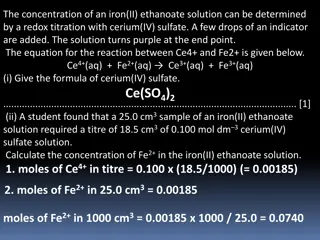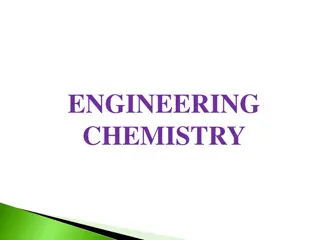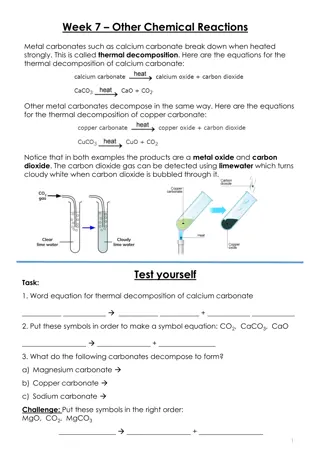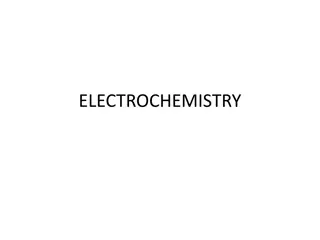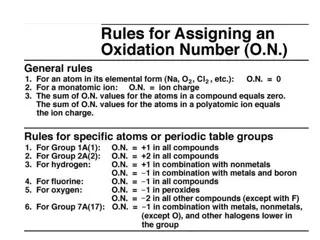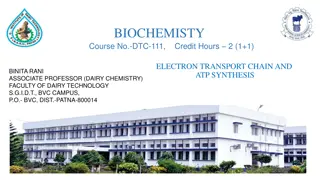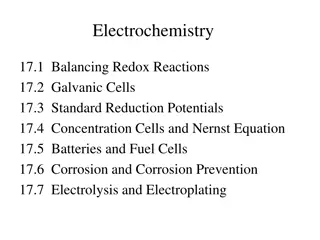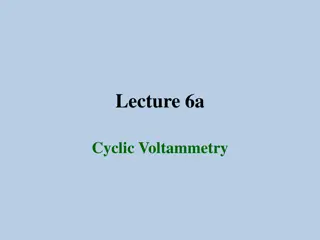Understanding Electrochemistry Concepts and Redox Reactions
Explore the fundamentals of electrochemistry, oxidation-reduction reactions, and identification of redox components. Learn about oxidation states, electron transfer, and half-reactions. Dive into examples and visual aids to grasp the concepts easily.
Download Presentation

Please find below an Image/Link to download the presentation.
The content on the website is provided AS IS for your information and personal use only. It may not be sold, licensed, or shared on other websites without obtaining consent from the author. Download presentation by click this link. If you encounter any issues during the download, it is possible that the publisher has removed the file from their server.
E N D
Presentation Transcript
homework Chapter 18 Electrochemistry AP Practice test
Oxidation-Reduction Reactions Redox or oxidation-reduction reactions are reactions that involve a transfer of electrons. Oxidation is the loss of electrons. Reduction is the gain of electrons. (think of the charge, OIL RIG) So in the reaction 4 K + O2 4 K++ 2 O2- Potassium get oxidized, oxygen get reduced
Oxidation States Oxidation state is the theoretical charge on all atoms if all bonds were ionic. The sum of the oxidation states must be equal to the charge of the ion or molecule.
Using oxidation states In the reaction 2 Na +2 H2O 2 NaOH + H2 0 +1 -2 +1 -2 +1 0 Note the changes Sodium went from 0 to 1 2 of the hydrogen atoms went from +1 to 0 (the other two were unchanged)
Identification of Redox Components. Specify which of the following equations represents oxidation-reduction reactions, and indicate the oxidizing agent, the reducing agent, the species being oxidized, and the species being reduced. CH4(g) + H2O(g) CO(g) + 3H2(g) 2AgNO3(aq) + Cu(s) Cu(NO3)2(aq) + 2Ag(s) 2 H+(aq) + 2CrO42-(aq) Cr2O72-(aq) + H2O(l)
CH4(g) + H2O(g) CO(g) + 3H2(g) -4 +1 +1 -2 +4 -2 0 C is oxidized, and H is reduced C is reducing agent, H is oxidizing agent 2AgNO3(aq) + Cu(s) Cu(NO3)2(aq) + 2Ag(s) +1 +5-2 0 +2 +5 -2 0 Ag is reduced, Cu is oxidized Ag is oxidizing agent, Cu is reducing agent Net Ionic 2Ag+(aq) + Cu(s) Cu2+(aq) + 2Ag(s) +1 0 +2 Ag is reduced, Cu is oxidized 0 2 H+(aq) + 2CrO42-(aq) Cr2O72-(aq) + H2O(l) +1 +6 -2 +6 -2 +1 -2 This is not a redox reaction
Half reactions Ce4++ Sn2+ Ce3+ + Sn4+ Half reactions Ce4++ e- Ce3+ Sn2+ 2e-+ Sn4+ Electrons lost must equal electrons gained! 2 Ce4++2 e- 2 Ce3+ Merge the two half reactions 2 Ce4++ Sn2+ 2 Ce3+ + Sn4+
Redox reactions in acidic solutions It will be noted in the problem Balance all elements except hydrogen and oxygen. Balance oxygen by adding H2O (which is always prevalent in an acidic solution) Balance hydrogen by adding H+ Then balance the charge adding electrons and proceed normally.
Example In an acidic solution Cr2O72-+ Cl- Cr3++ Cl2 Half reactions Cr2O72- Cr3+ Cl- Cl2
Reduction side Cr2O72- Cr3+ Cr2O72- 2 Cr3+ Cr2O72- 2 Cr3+ + 7 H2O Cr2O72-+ 14 H+ 2 Cr3+ + 7 H2O Cr2O72-+ 14 H++ 6 e- 2Cr3++7 H2O
Oxidation side Cl- Cl2 2 Cl- Cl2 2 Cl- Cl2 + 2 e- I have to equal 6 e-so multiply by 3 6 Cl- 3 Cl2 + 6 e-
Combine my half reactions Cr2O72-+ 14 H++ 6 e- 2 Cr3+ + 7 H2O 6 Cl- 3 Cl2+ 6 e- And you get Cr2O72-+14 H++6Cl- 2Cr3++3 Cl2+7H2O The electrons cancel out .
Example In an acidic solution MnO4-+ H2O2 Mn2+ + O2 Half reactions MnO4- Mn2+ H2O2 O2
Top Equation MnO4- Mn2+ MnO4- Mn2+ + 4 H2O MnO4-+ 8 H+ Mn2+ + 4 H2O MnO4-+ 8 H++ 5 e- Mn2+ + 4 H2O
Bottom Equation H2O2 O2 H2O2 O2 + 2 H+ H2O2 O2 + 2 H+ + 2 e- I need to equal 5 e-so That won t work 2MnO4-+ 16 H++ 10 e- 2 Mn2+ + 8 H2O 5 H2O2 5 O2 + 10 H+ + 10 e-
Add them together 2MnO4-+ 16 H++ 10 e- 2 Mn2+ + 8 H2O 5 H2O2 5 O2 + 10 H+ + 10 e- And you get 2 MnO4-+ 6 H++ 5 H2O2 2 Mn2+ + 5 O2 + 8 H2O Notice the H+ canceled out as well.
Balancing Redox Equations in a basic solution Look for the words basic or alkaline Follow all rules for an acidic solution. After you have completed the acidic reaction add OH-to each side to neutralize any H+. Combine OH-and H+to make H2O. Cancel out any extra waters from both sides of the equation.
Example We will use the same equation as before In a basic solution MnO4-+ H2O2 Mn2+ + O2 2 MnO4-+ 6 H++ 5 H2O2 2 Mn2+ + 5 O2 + 8 H2O
Basic solution Since this is a basic solution we can t have excess H+. We will add OH-to each side to neutralize all H+ 2 MnO4-+ 6 H++ 5 H2O2+ 6OH- 2 Mn2+ +5 O2 +8 H2O + 6OH- We added 6 OH-because there were 6H+
Cont. H+ + OH- H2O Combine the hydroxide and hydrogen on the reactant side to make water 2 MnO4-+ 6 H2O + 5 H2O2 2 Mn2++ 5 O2+ 8 H2O + 6OH- Cancel out waters on both sides 2 MnO4-+ 5 H2O2 2 Mn2+ + 5 O2 +2 H2O +6OH-
Another example In a basic solution MnO4 + SO32- MnO4 2 + SO42- Half reactions MnO4 MnO4 2 SO32- SO42-
Half reactions MnO4 MnO4 2 MnO4 -+ e- MnO4 2 SO32- SO42- H2O + SO32- SO42- H2O + SO32- SO42-+ 2 H+ H2O + SO32- SO42-+ 2 H+ +2e- Double the top reaction
2 MnO4 -+ 2 e- 2 MnO4 2 H2O + SO32- SO42-+ 2 H+ +2e- Combine them 2 MnO4 -+ H2O + SO32- 2 MnO4 2 +SO42-+ 2 H+ Add OH- 2 MnO4 -+ H2O + SO32-+ 2 OH- 2 MnO4 2 +SO42-+2 H++2 OH-
2 MnO4 -+ H2O + SO32-+ 2 OH- 2 MnO4 2 +SO42-+ 2 H2O finishing 2 MnO4 -+ SO32-+ 2 OH- 2 MnO4 2 +SO42-+ H2O
Major Redox Points to Remember. Any redox reaction can be treated as the sum of the reduction and oxidation half- reactions. Mass (atoms) and charge are conserved in each half-reaction. Electrons lost in one half-reaction are gained in the other. Even though the half-reactions are treated separately, electron loss and electron gain occur simultaneously.
Galvanic cell A galvanic cell is a device in which chemical energy is changed to electrical energy. A galvanic cell uses a thermodynanamically favored or spontaneous redox reaction to produce an electric current that can be used to do work. The system does work on the surroundings. A redox reaction involves the transfer of electrons from the reducing agent to the oxidizing agent.
Oxidation v reduction Oxidation. * Involves a loss of electrons. * Increase in oxidation number. * To get more positive. * Occurs at the anode of a galvanic cell. An Ox Reduction. * Involves a gain of electrons. * Decrease in oxidation number. * To get more negative. * Occurs at the cathode of a galvanic cell. Red Cat
Production of Current Oxidation Reactions involve a transfer of electrons. Electric current is a movement of electrons. In order to produce a usable current, the electrons must be forced across a set path (circuit). In order to accomplish this, an oxidizing agent and something to oxidize must be separated from a reducing agent with something to reduce.
Pictures Oxidation reduction reaction in the same container will have electrons transferring, but we can t harness them. Separating the oxidation reaction from the reduction reaction, but connecting them by a wire would allow only electrons to flow. oxidation reduction Oxidation Reduction
Closer look X X+ + e- X+ + e- X Oxidation Reduction We now have excess electrons being formed in the oxidizing solution and a need for electrons in the reducing solution with a path for them to flow through. However, if electrons did flow through the wire it would cause a negative and positive solution to form.
Thats not possible Or at least it would require a lot of energy. A negative solution would theoretically be formed by adding electrons, and a positive one by removing electrons. The negative solution would then repel the electrons and stop them from flowing in, and a positive solution would attract the electrons pulling them back where they came from. Making it so the charged solutions wouldn t form. In order for this to work, I would need a way for ions to flow back and forth but keeping the solutions mostly separated.
The Salt Bridge or the Porous Disk. These devices allow ion flow to occur (circuit completion) without mixing the solutions. They are typically made of sodium sulfate or potassium nitrate
Closer look e- e- e- Salt Bridge X X+ + e- X+ + e- X Oxidation Reduction Now electrons can flow across the wire from the oxidation reaction to the reduction reaction. As the oxidation reaction becomes positive, it removes negative ions and adds positive ions to the salt bridge. The reduction reaction does the reverse.
e- Closer look e- Salt Bridge - ion + ion Oxidation side e- + ion - ion - ion + ion + ion - ion Zooming in on the oxidizing side This would make the salt bridge positive
e- Closer look e- Salt Bridge - ion + ion - ion e- + ion - ion Reducing side + ion - ion + ion (Zooming in on the reducing side) if the reverse wasn t happening on this side.
Close up of salt bridge + ion + ion + ion - ion - ion - ion - ion - ion + ion + ion + ion - ion The ions keep flowing in the salt bridge to keep everything neutral. Electrons do also travel across the salt bridge. This decreases the cell s effectiveness.
Electrochemical cell This is the basic unit of a battery. It is also called a galvanic cell, batteries have two or more galvanic cells linked together. Electrochemical cells always have two terminals. The terminal where oxidation occurs is called the anode. The terminal where reduction occurs is called the cathode.
Voltaic Cell: Anode Reaction At the anode, the metal at the terminal is losing electrons going from metallic state to an aqueous state. Over time the anode loses mass due to this. Zn(s) Zn(s) Zn2+ (aq)
Voltaic Cell: Cathode Reaction At the Cathode, the metal at the terminal is gaining electrons going from aqueous to a metallic state. Over time the cathode gains mass due to this. Ag(s) Ag(s) Ag+ (aq) Ag+ (aq)


